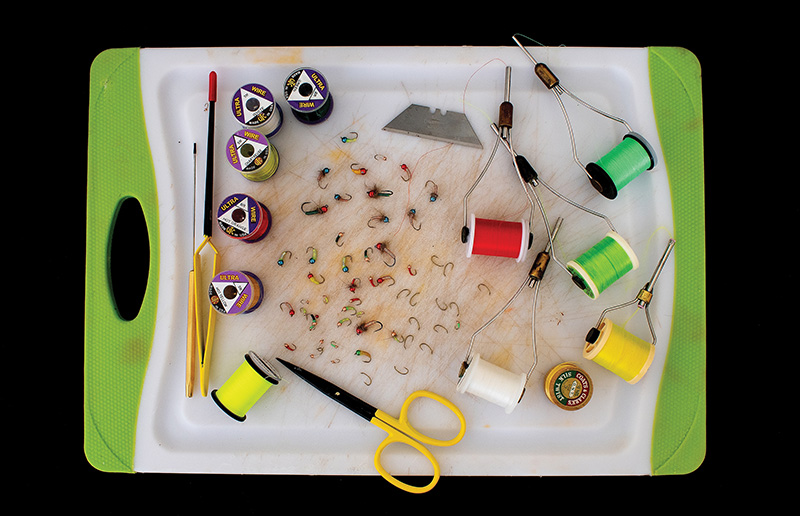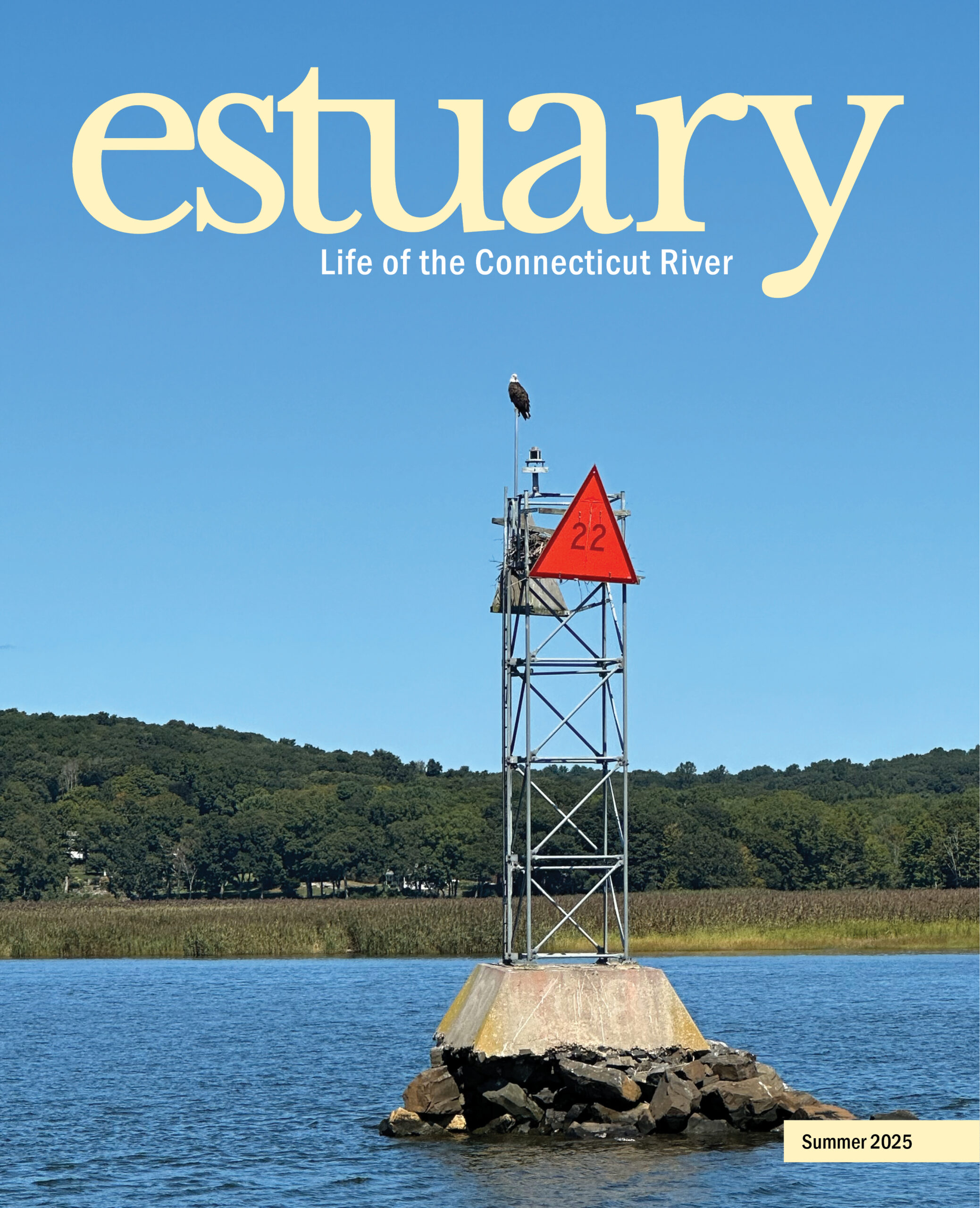 This article appears in the Summer 2025 issue
This article appears in the Summer 2025 issue
 Caddis Pupae
Caddis Pupae
Story and Photos by Ed Mitchell
Avid trout anglers learn not only about the fish but the working of the watershed. Yes, we want to be completely in touch with our rivers. And one aspect of that desire is to study aquatic macro invertebrates. Tucked under rocks, buried in the mud, encased in gravel and sand, they abide on the riverbed, an essential part of the trout’s food chain.
I asked Mike Beauchene, Supervising Fisheries Biologist for the Connecticut DEEP, to comment on macro invertebrates. He replied, “The most common are what biologist call the ‘EPT’ metric—Ephemeroptera, Plecoptera, and Trichoptera. Better known to anglers as the mayflies, the stoneflies, and the caddisflies.”
Of the three, historically, mayflies have far and away gotten the most attention from anglers. Our bookshelves are burdened with reference texts written about them. Their hatches become seasonal signposts, carrying us through each year. And their life stages—nymphs, duns, and spinners—are the vocabulary of our conversations.
Despite our devotion to mayflies, with increasing years I find myself focusing more and more attention on the order Trichoptera—the caddisflies. Granted, they are not as legendary or graceful as mayfly duns riding the riffle. Nor have caddis traditionally played as big a role in our sport. Yet on today’s waters, caddisflies are often more prevalent than mayflies and therefore more significant to our angling success.
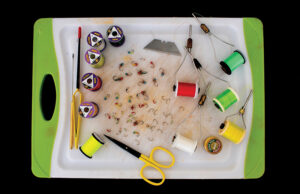
Get your materials ready.
With that in mind, let’s tie a selection of flies matching caddis pupae in shape, size, and color. Assembling tying tools and materials is the first step. Several manufacturers offer hooks specially designed for tying caddis pupae. The one I have on hand is the Tiemco 2847. It is down eye, 2x heavy, 2x wide, 2x short, with the required curved shank.
Caddis in our streams vary from the miniscule micro caddis of midsummer to the giant orange caddis of October. To cover that range, I am using hooks from size 10# down to size 24#. In addition, I highly recommend tying a few heavy pupae on a jig hook. Mine is a size 10# Firehole 523. Later on in this article, we’ll return to these jig flies and discuss how to employ them to improve your fishing success.
All of my pupae flies boast a tungsten bead, and I recommend all yours do as well. Every experienced angler realizes that the deeper you present a mayfly “nymph” or a stonefly “nymph” the more successful it becomes. And the same holds true for caddis pupae. Granted, as an alternative you might add split shot to your leader. But split shot is a nuisance to handle and no longer legal in many states including Massachusetts, Vermont, and New Hampshire. Moreover, tungsten beads are heavier than lead, delivering your fly quicker to the fish and causing fewer tangles in your leader.
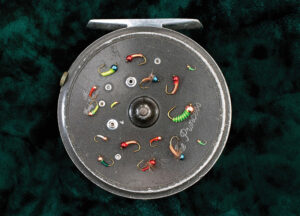
Caddis pupae flies size 10# to size 24#.
Always match the size of the bead to the size of the hook. Too small a bead will be hard to get on the hook and cause your fly to sink slower; too big a bead reduces the hook gap. To give you some idea, for size 10# flies I picked a 3.2 mm bead; for size 12# and 14# a 2.8mm; for size 16# a 2.4 mm; and for size 24# a 1.5 mm bead. Next, beware that some brands of beads may prove difficult to get around the bend on some brands of hooks. Ask your fly shop for advice. They will help you out.
Lastly, even with the right bead and the right hook, getting tiny tungsten beads on tiny hooks may test your courage. Admittedly I launched a swear word or two, dropping more than one bead, forever disappearing across the room. After some experimentations, my solution was to use Loon Outdoors D-Locking Tweezers to grip the hook and forceps to grip the bead. Not a perfect remedy. But together these two tools helped me considerably to get the job done. Give it a try.
Onward to thread. For the larger pupae, sizes 10# through 14#, I’ve employed the popular Danville Flat Waxed nylon in 210 Denier. Sturdy stuff. On the smaller hooks, I switched to Swedish-made Veevus in sizes 8/0 and 10/0. It is fine diameter and very strong, perfect for delicate work. And in all cases, I attempted to match my thread color to the color I’ve planned for the fly body.
To imitate that grub-like shape of caddis pupae, I mainly relied on copper wire in three sizes—medium, brassie, and x-small—and in a variety of colors. Copper wire makes a segmented body, is easy to work with, is durable, and adds weight. These are all good properties, and unlike some materials, copper wire does not change color when wet. Amongst my fly-tying materials, I also have a decent amount of Coats & Clark’s silk button hole twist, which works well on flies down to size 16#. While it does not add weight like copper wire, it makes a segmented body, is easy to work, and comes in an enormous variety of colors. Also note, like copper wire, silk does not change color when wet. What you see in the vise is what you get in the stream. I like that very much. And lastly, on the smallest hooks I made a few with just thread bodies.
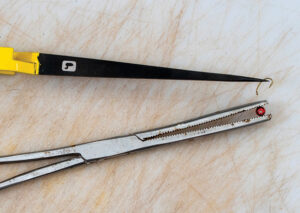
How to handle small hooks and beads.
In the color department: for pupae flies you can’t go wrong with green, cream, or tan. They’re excellent choices. That said, two very effective colors are plain copper wire and bright red. While neither is natural, both are visible in stained water and trout seem highly attracted to red, particularly in small flies. They are deadly, believe me.
Okay, let’s turn our attention to fishing these flies. Day in and day out, micro pupae flies (those size 18# on down) are often the most effective. Unfortunately, they are also difficult to properly present. Even with a tungsten bead, they are near weightless and hard to keep in touch with during a drift. If you do tight-line nymphing or euro-nymphing you already have the answer. On the point of your leader, tie on one of the heavy jig flies I mentioned earlier. Next attach your small pupae above it on a dropper. The jig fly delivers your rig down fast and straightens out the leader, helping you feel any strike. And since the jig fly rides point up, it is less apt to snag the bottom than a conventional hook.
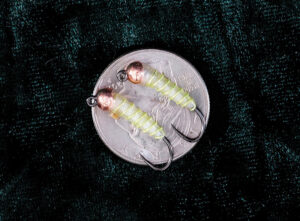
Heavy flies on jig hooks.
Allow me a final word about macro invertebrates. Scientific studies have revealed that mayflies are declining worldwide. The cause of this decline is likely multifaceted and probably affecting caddis and stoneflies as well. Fertilizer runoff from our lawns and farms is certainly a factor, especially when you realize that many fertilizers are laced with insecticides. Habitat destruction is another problem, as is climate change. Once again, we have ample reasons to support all efforts to reverse climate change and maintain clean waters.
Ed Mitchell is the author of four books about fly-fishing and has written for many magazines. He has over fifty years of experience in both fresh and saltwater fly-fishing.

